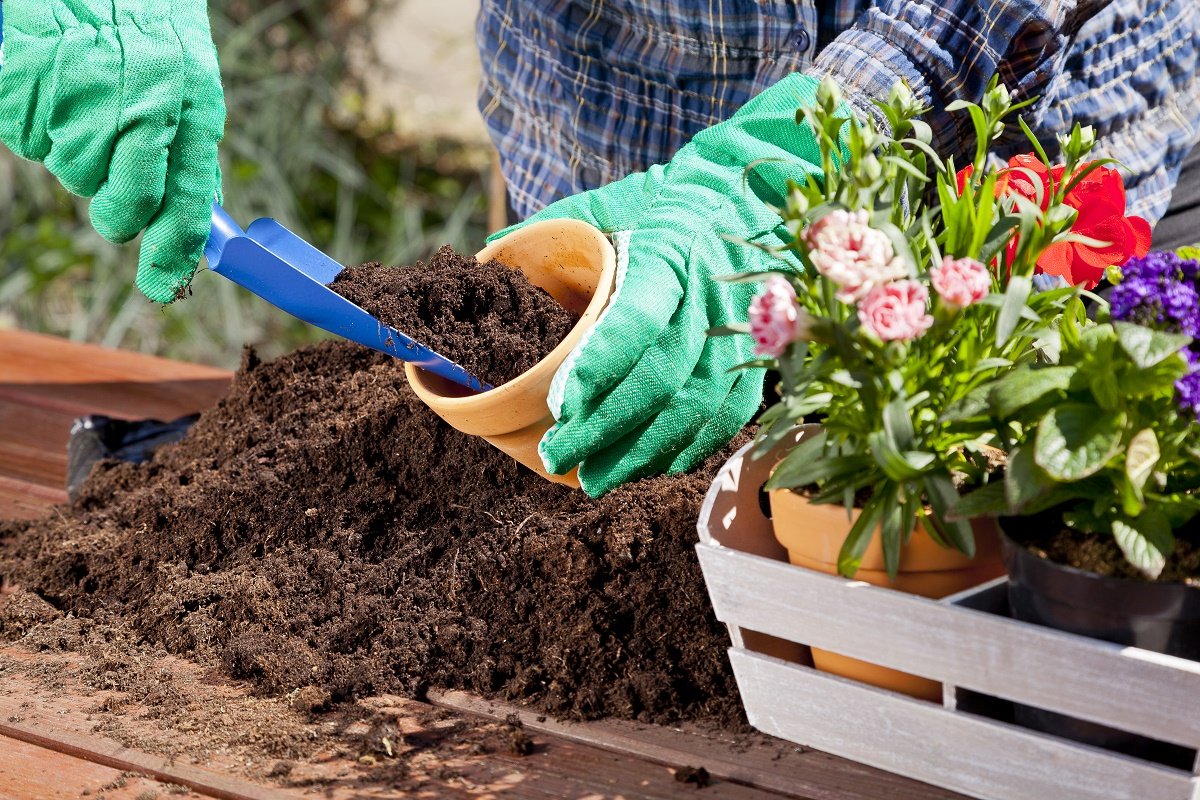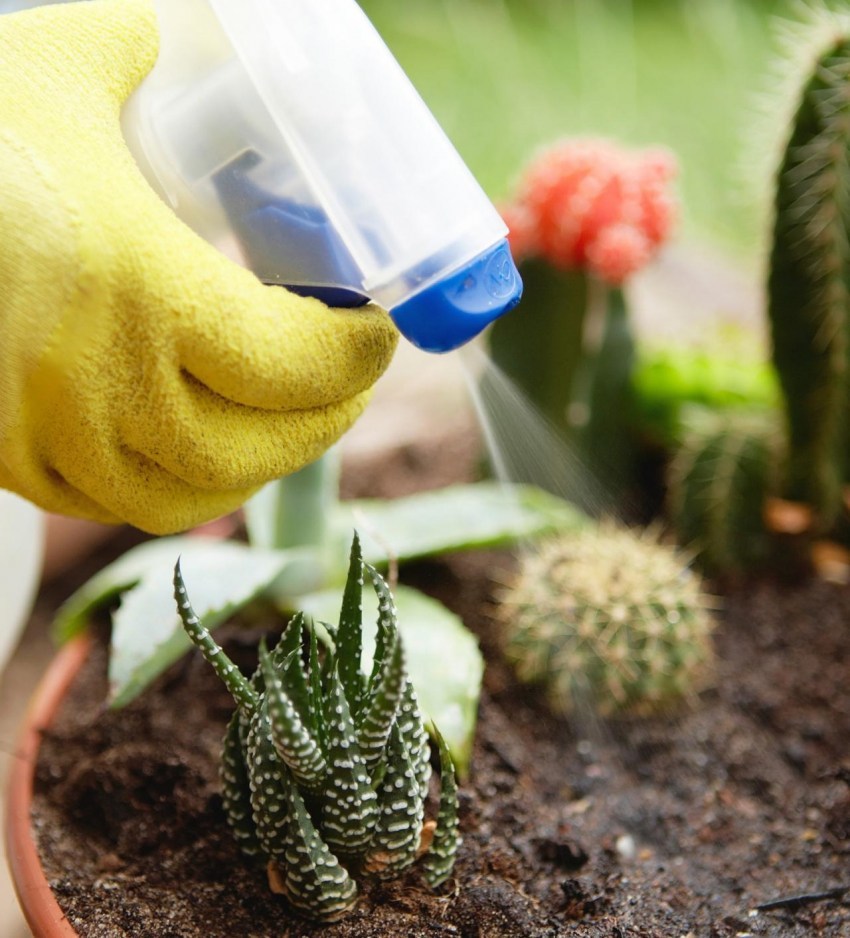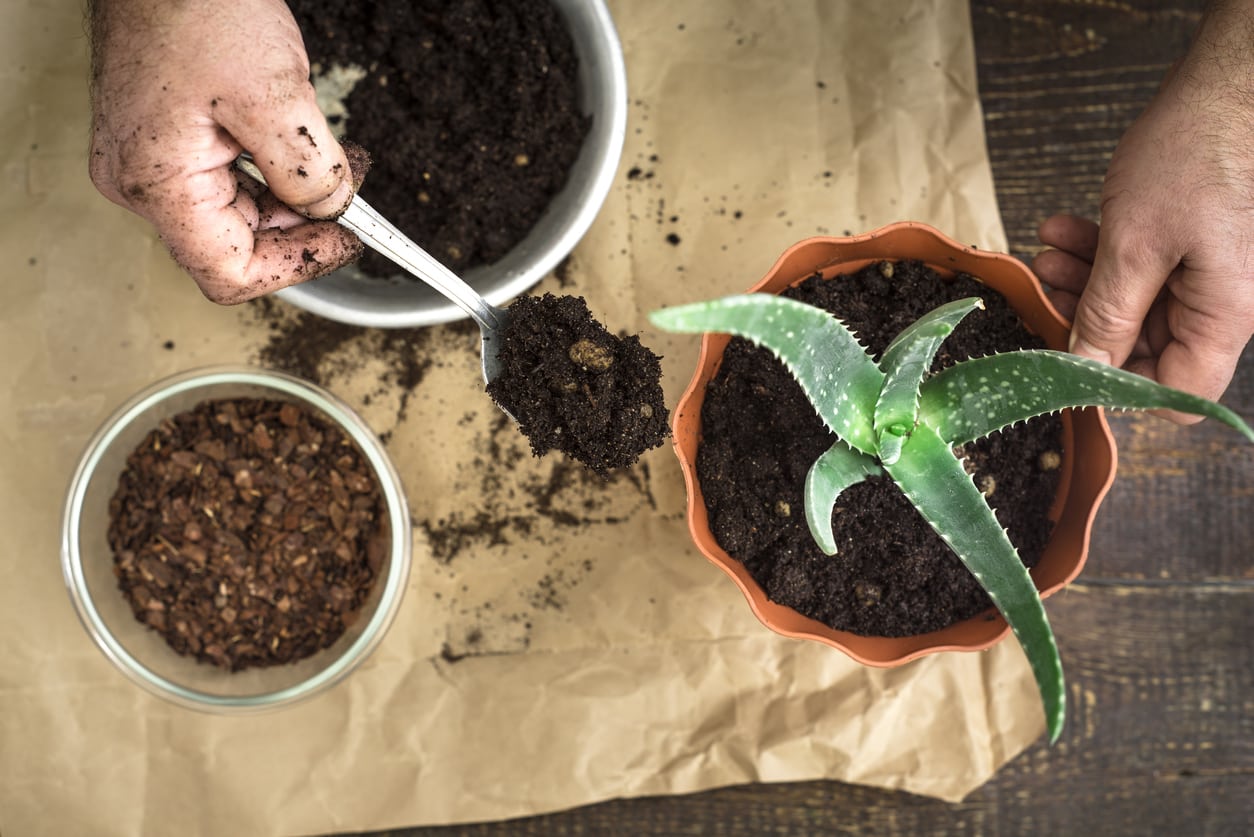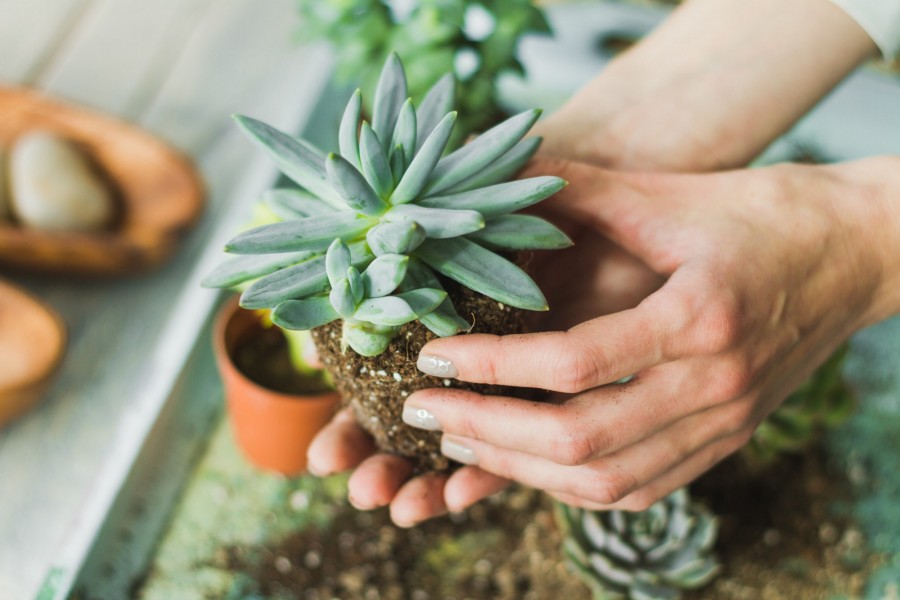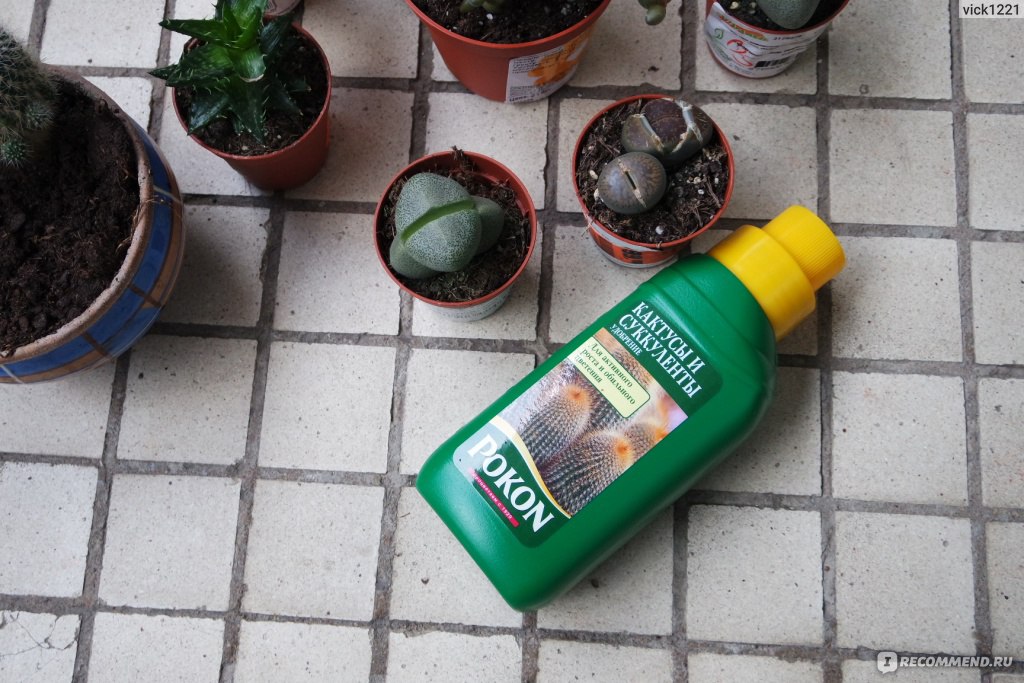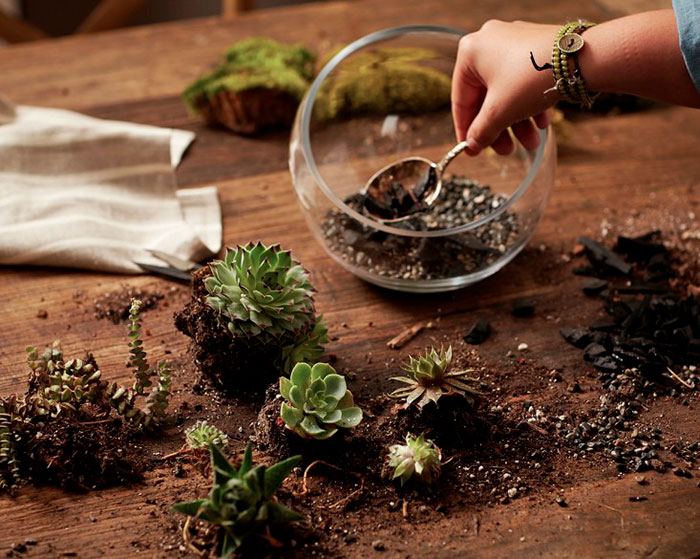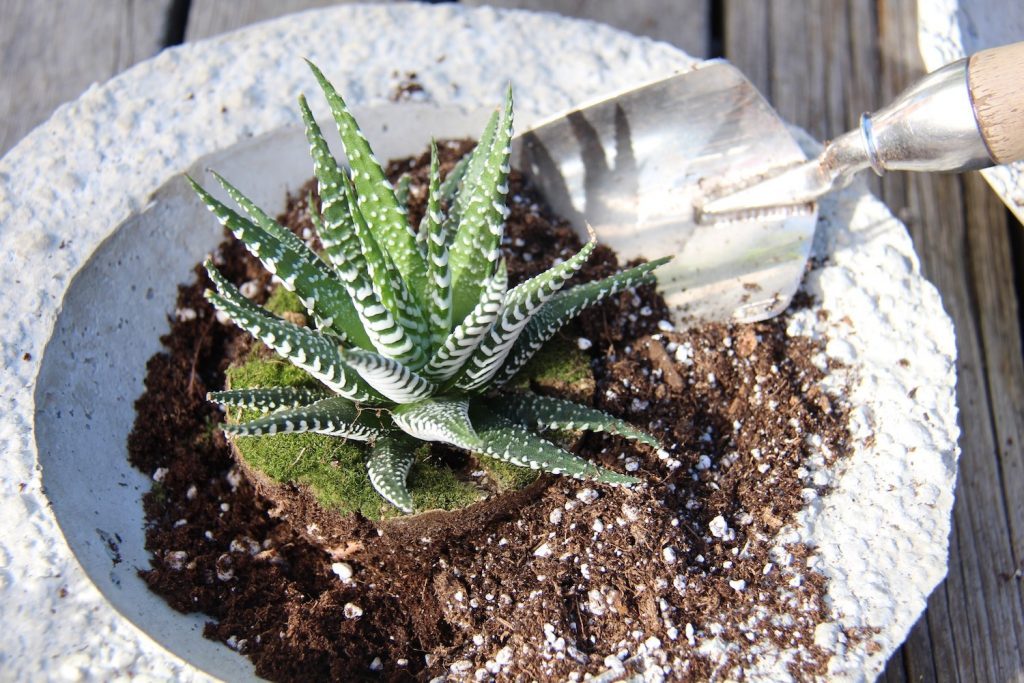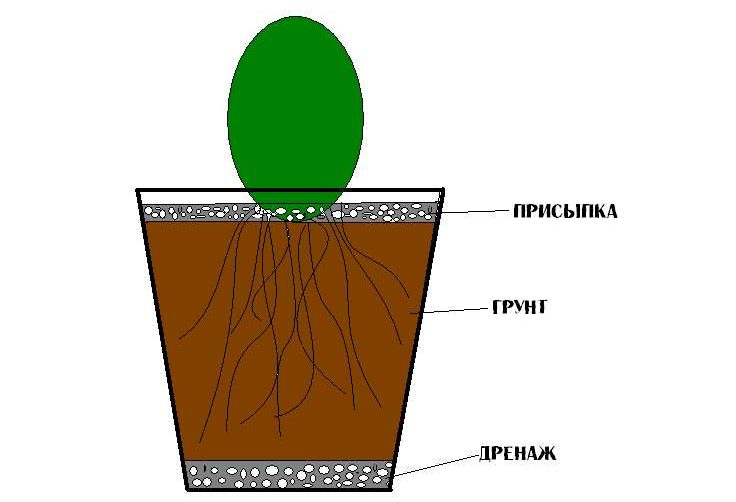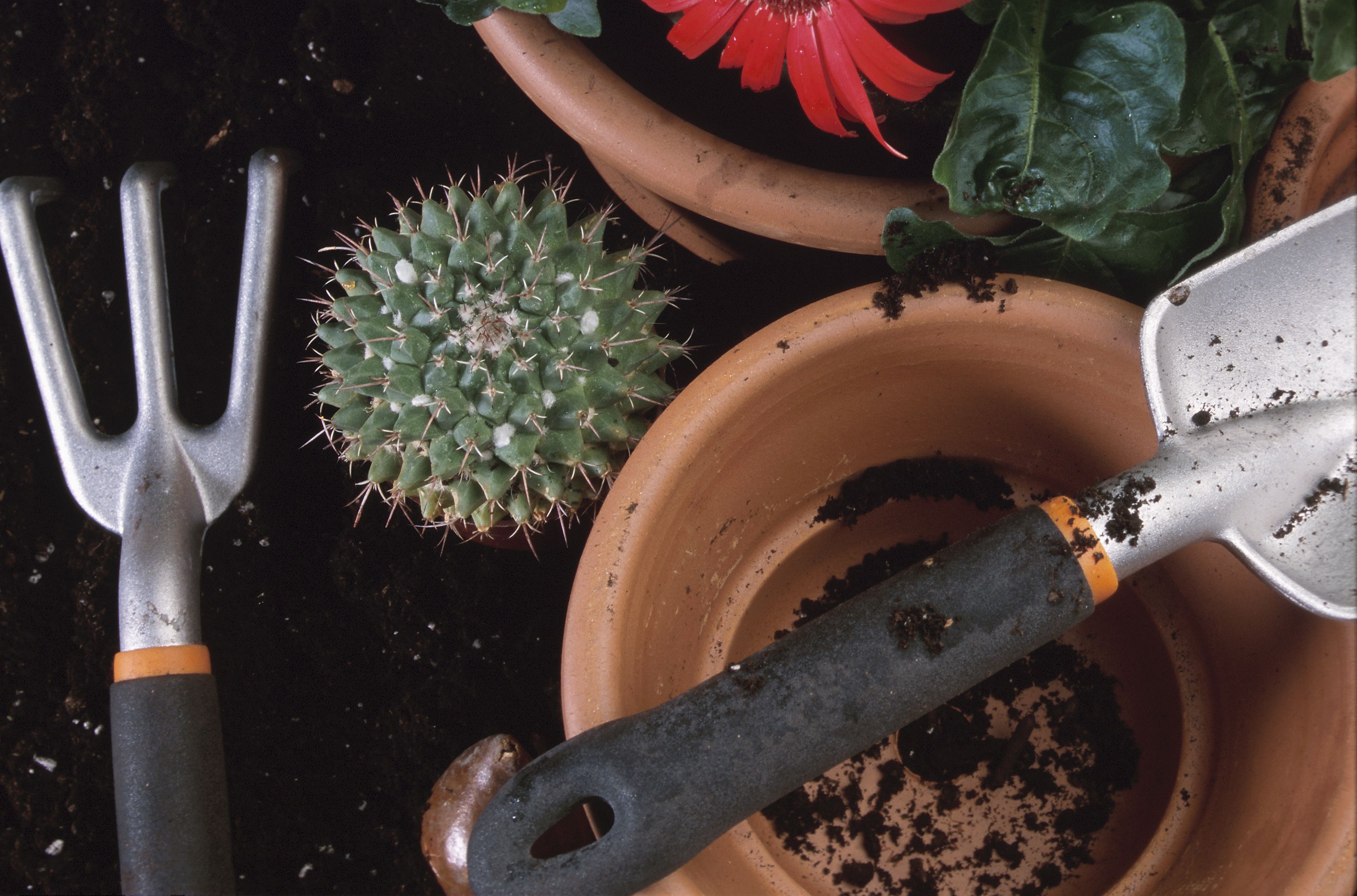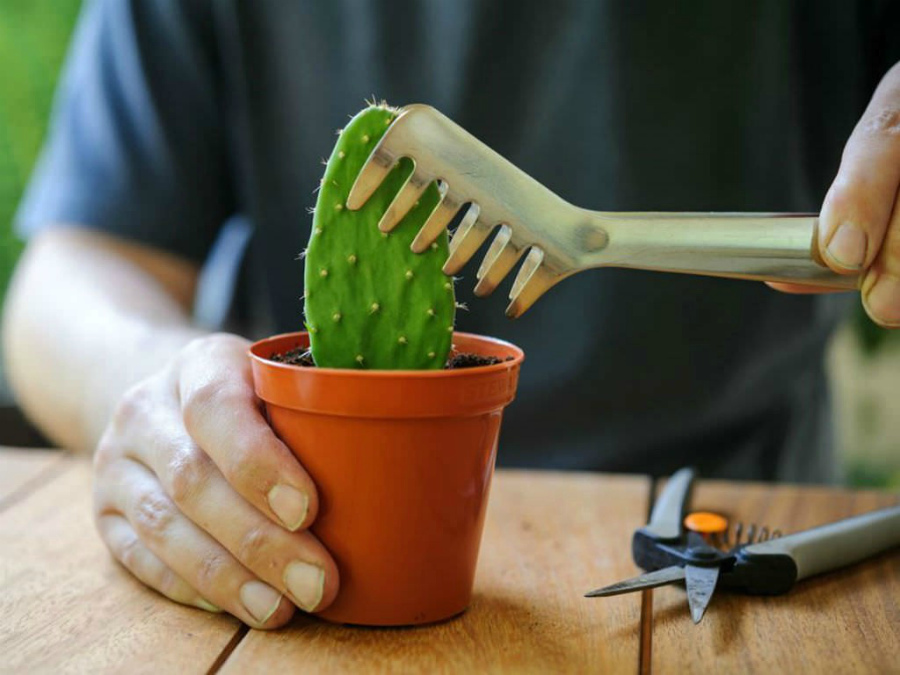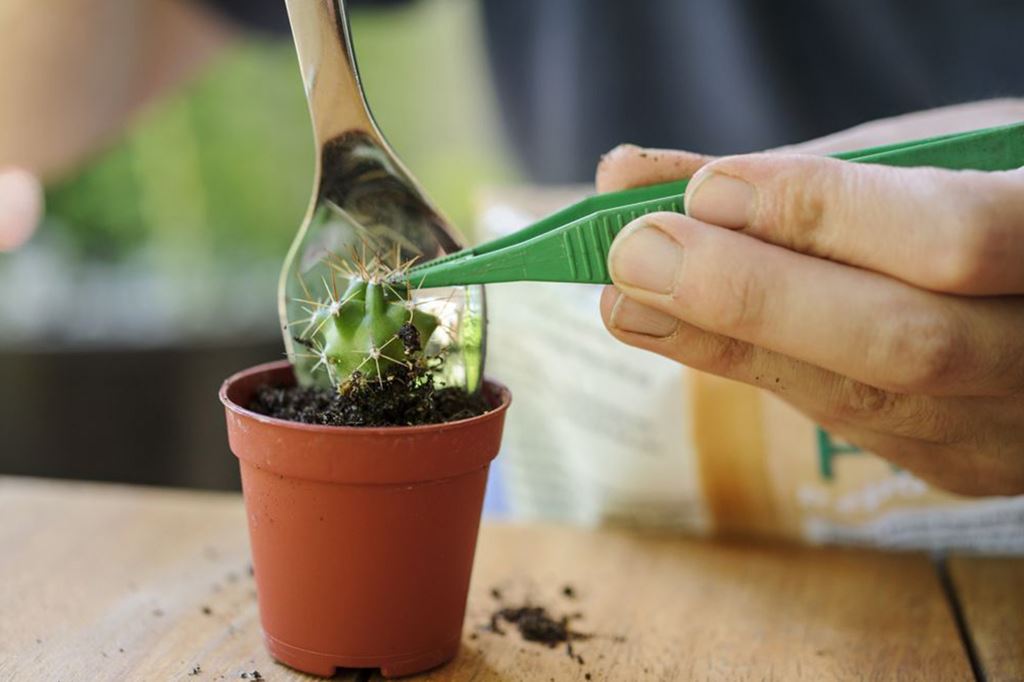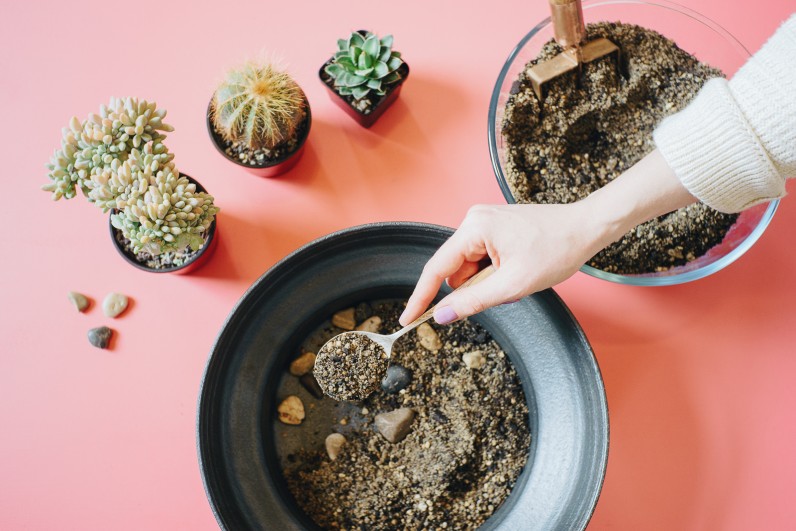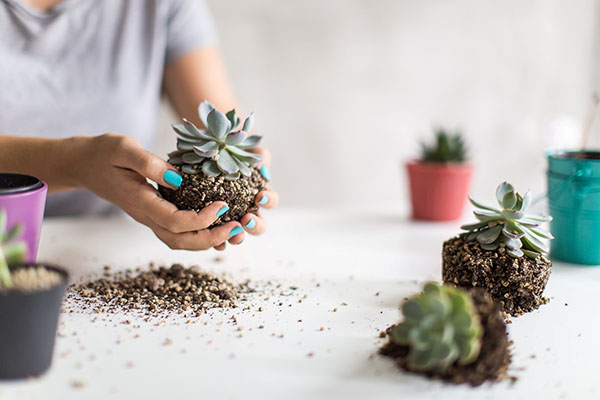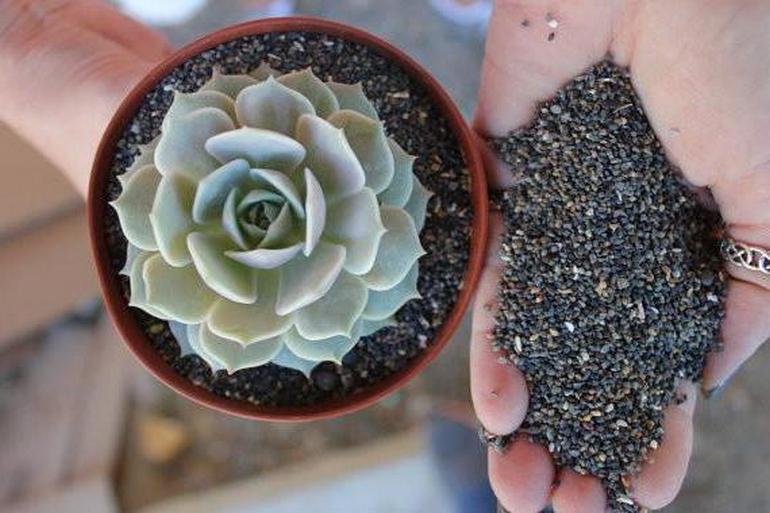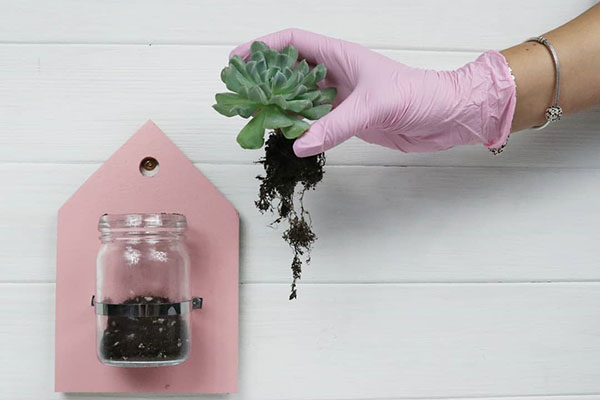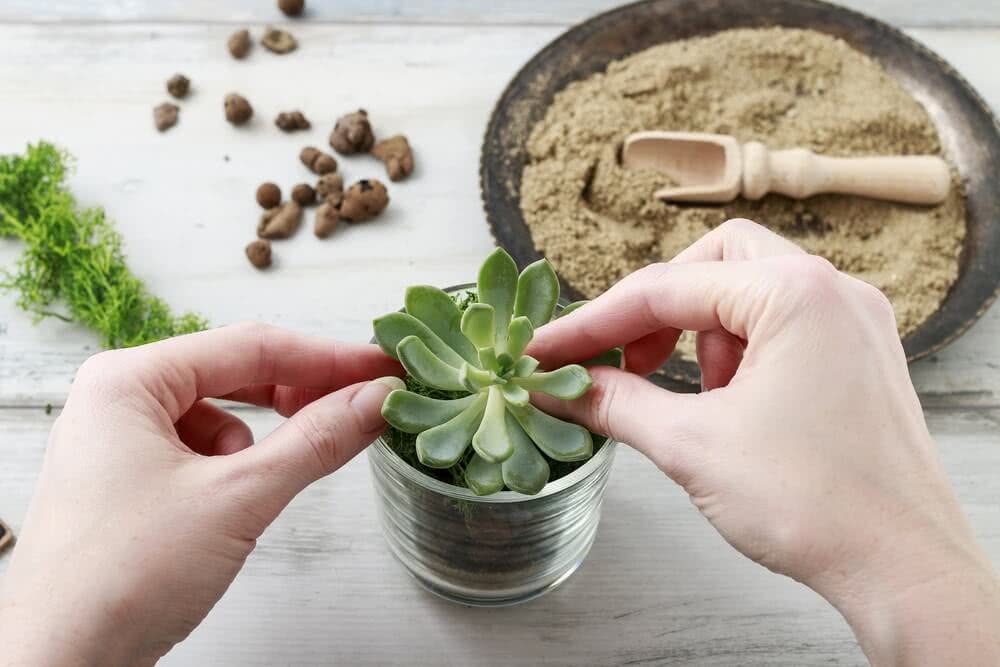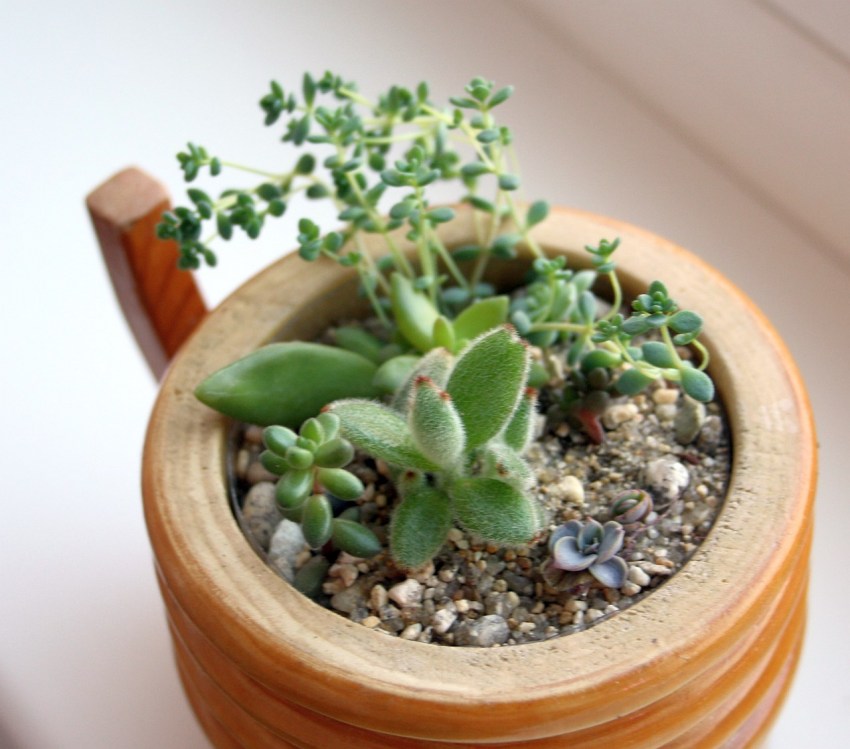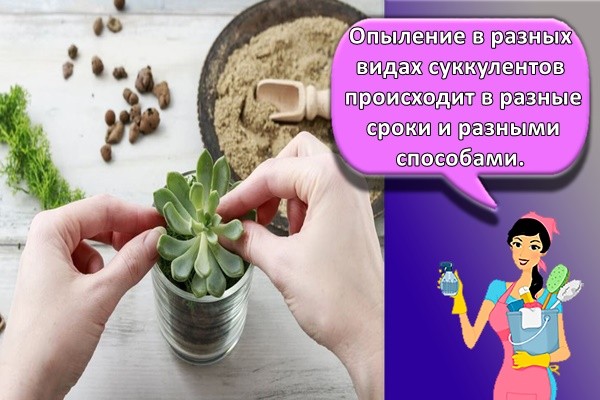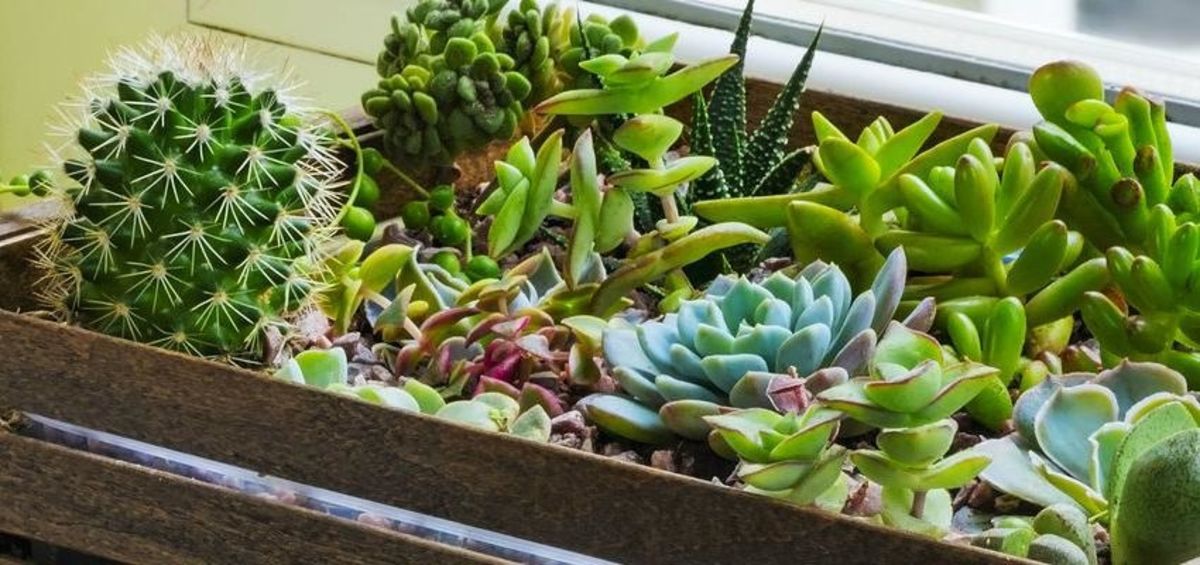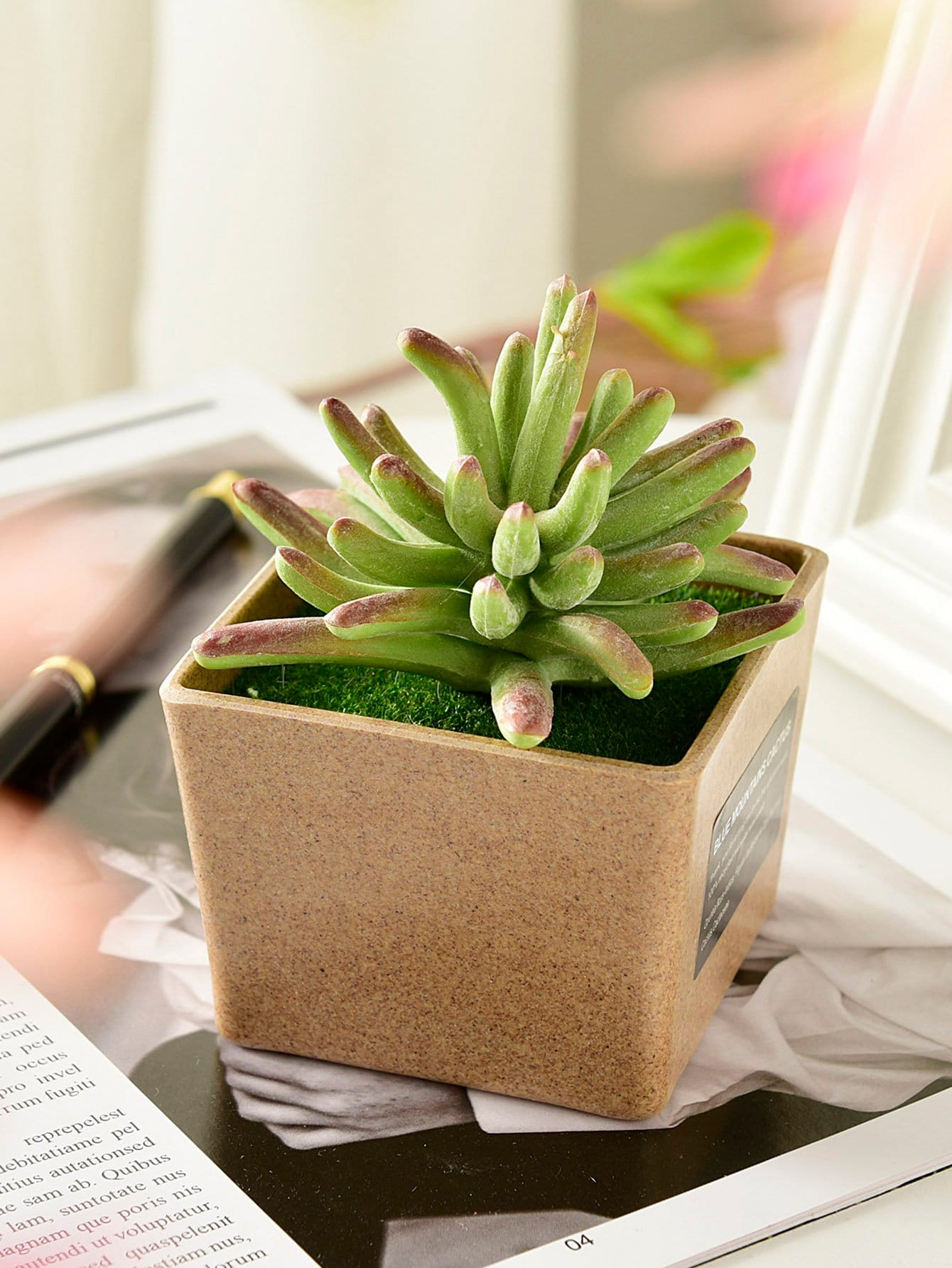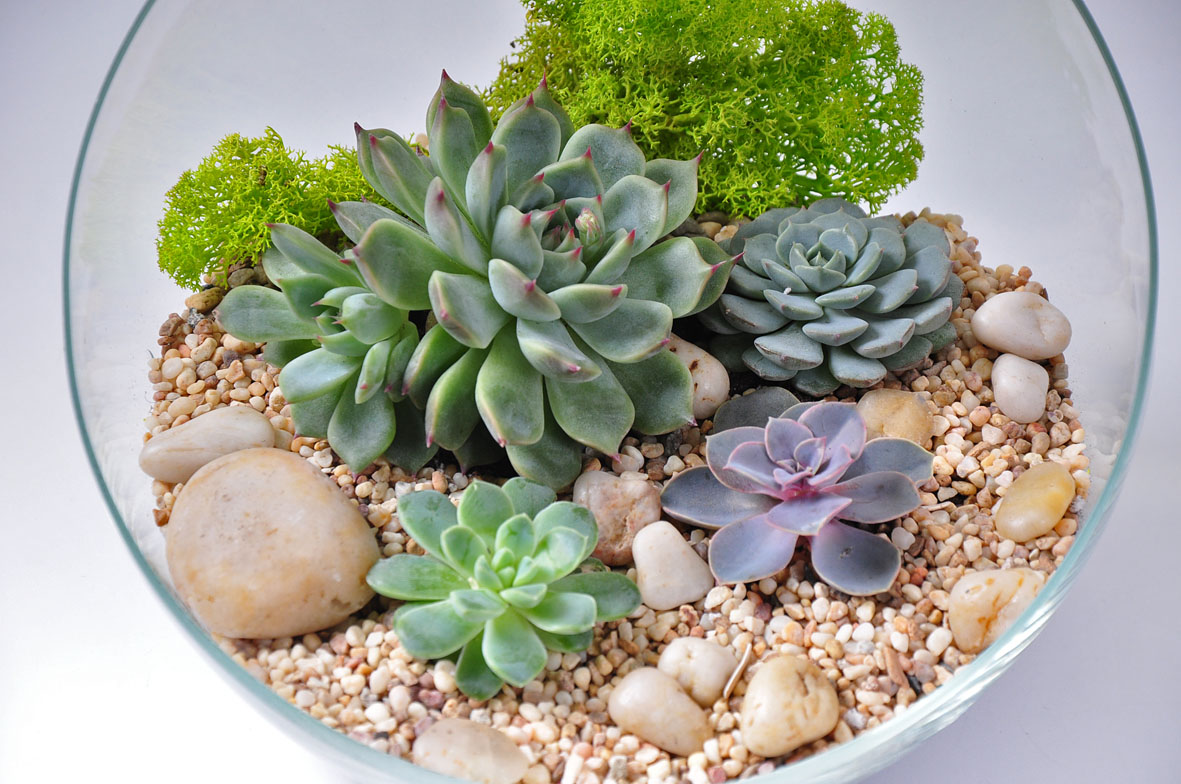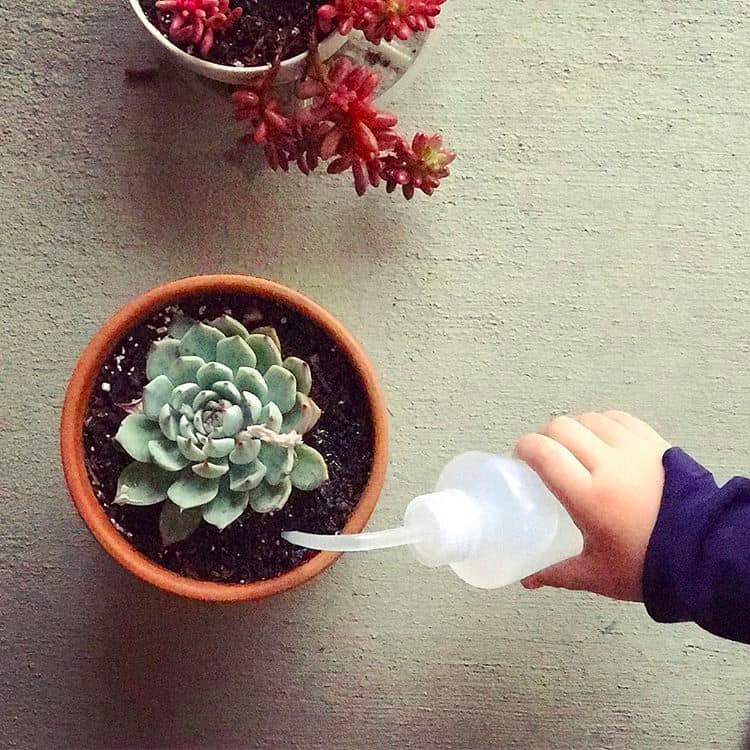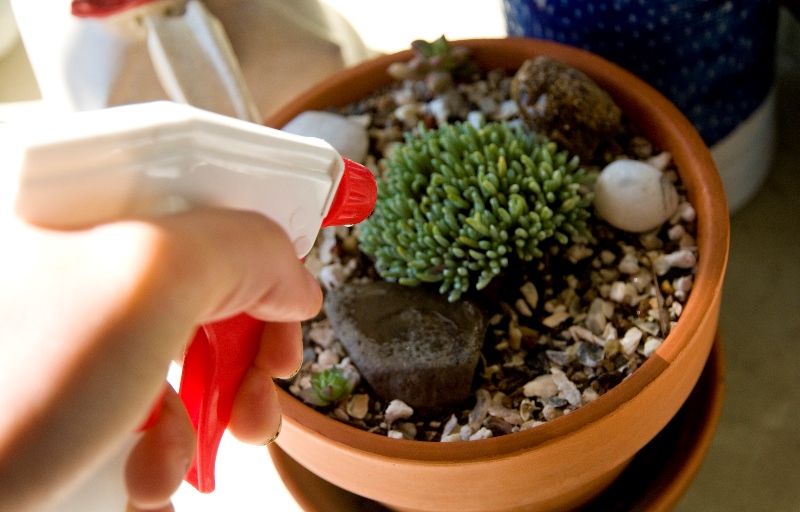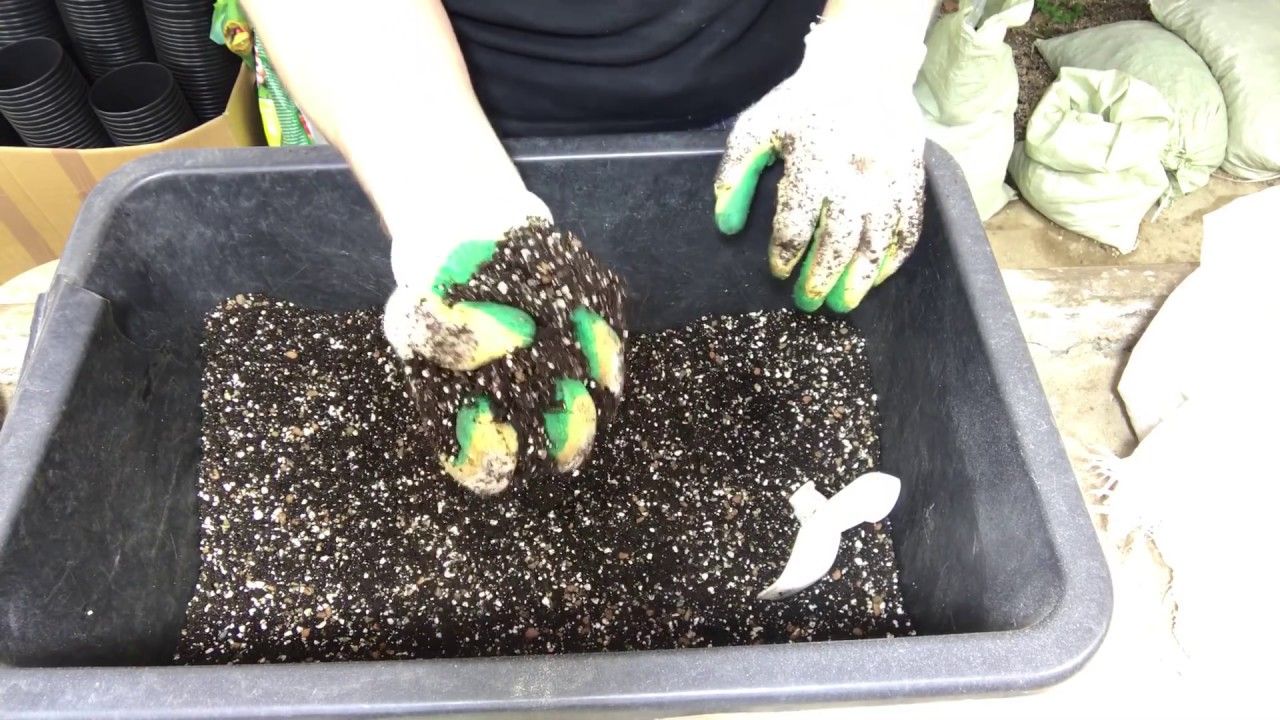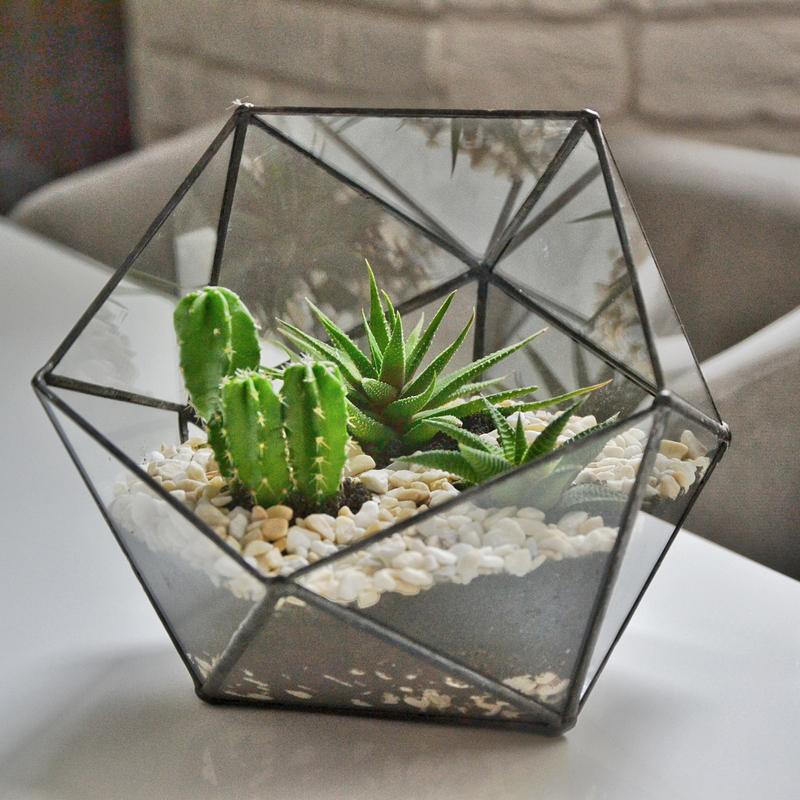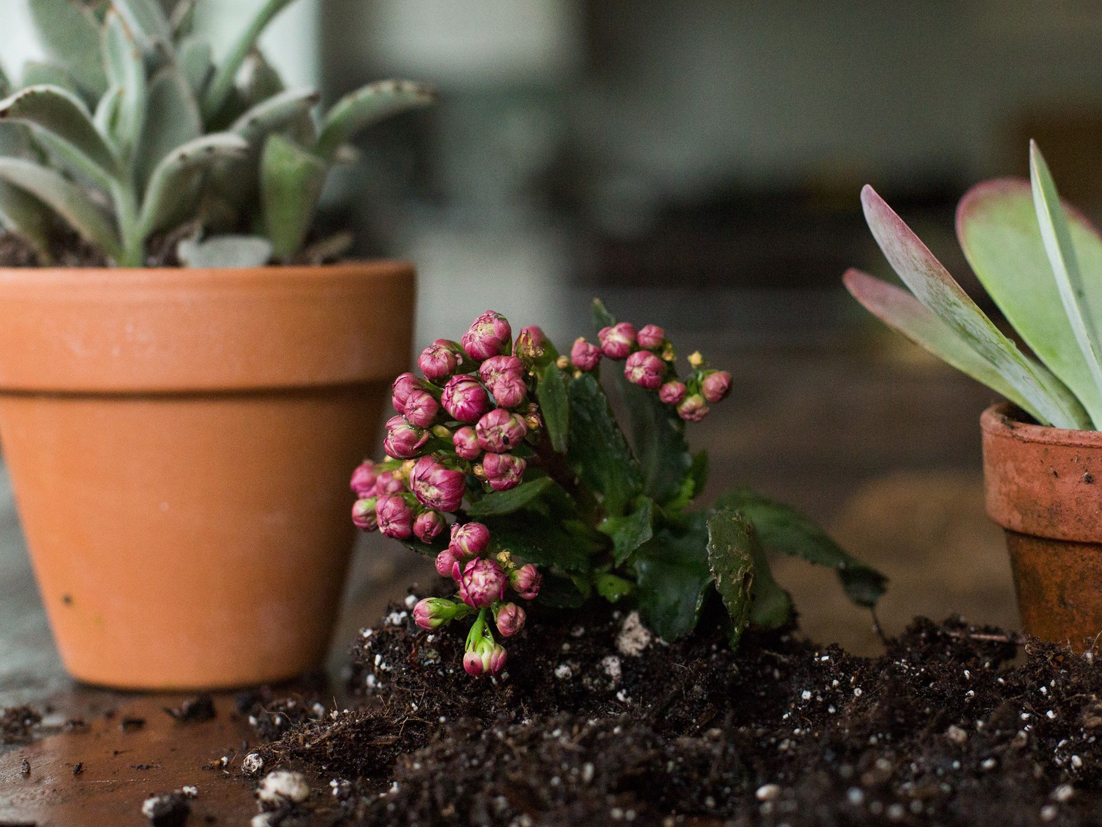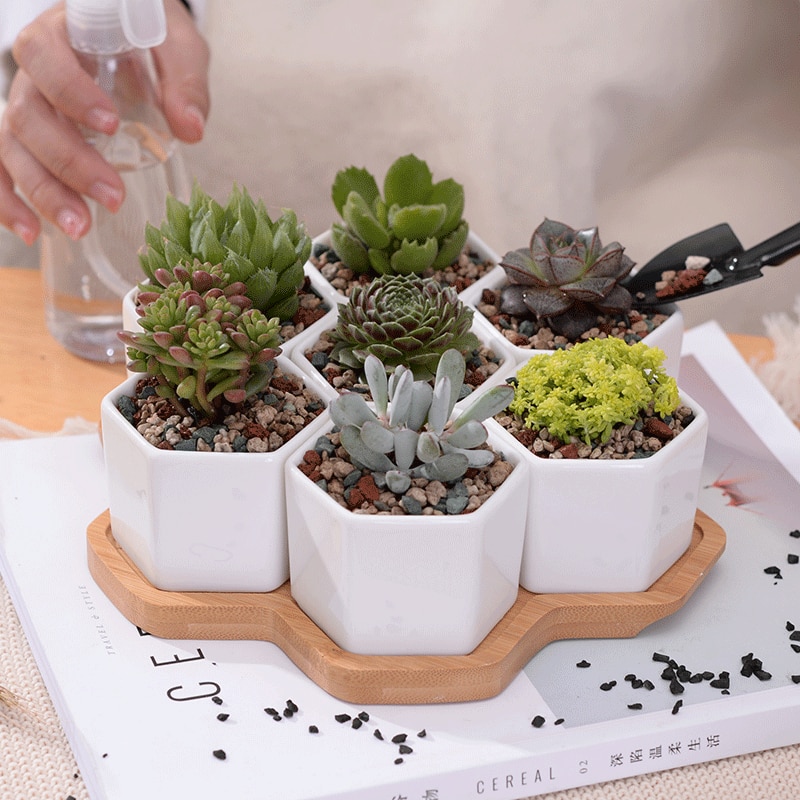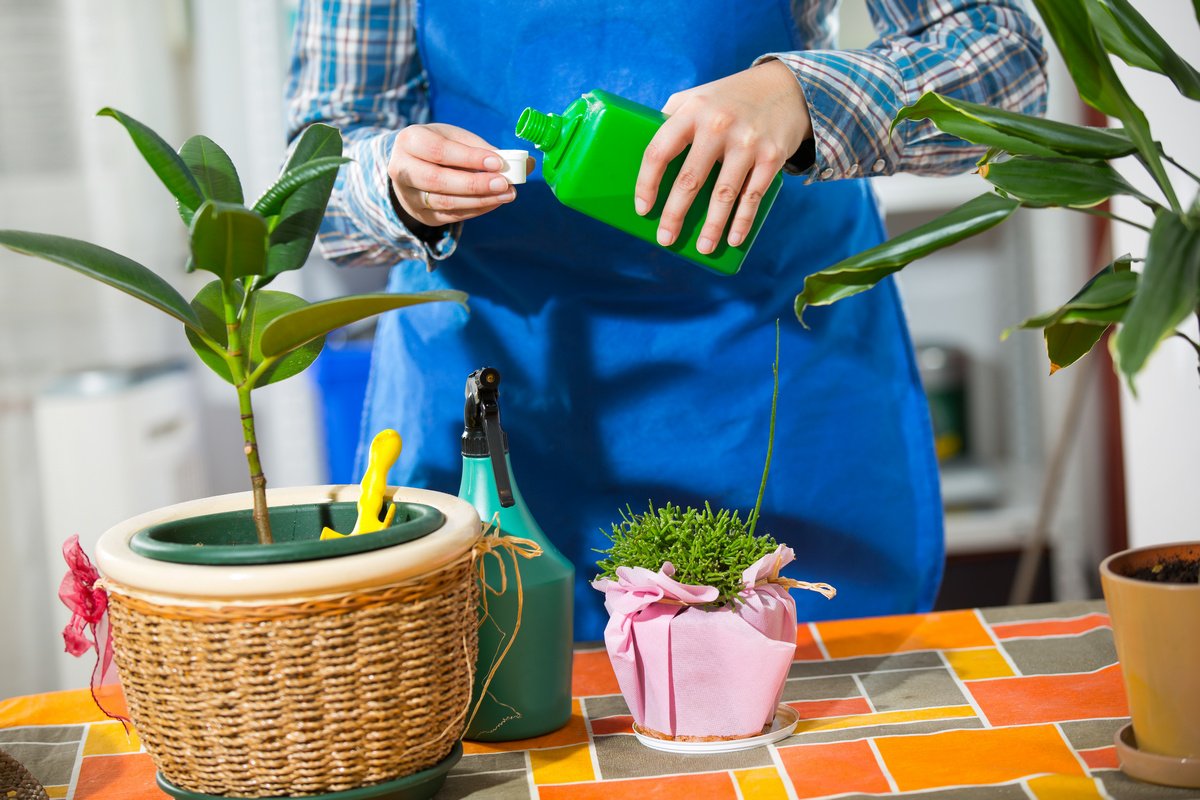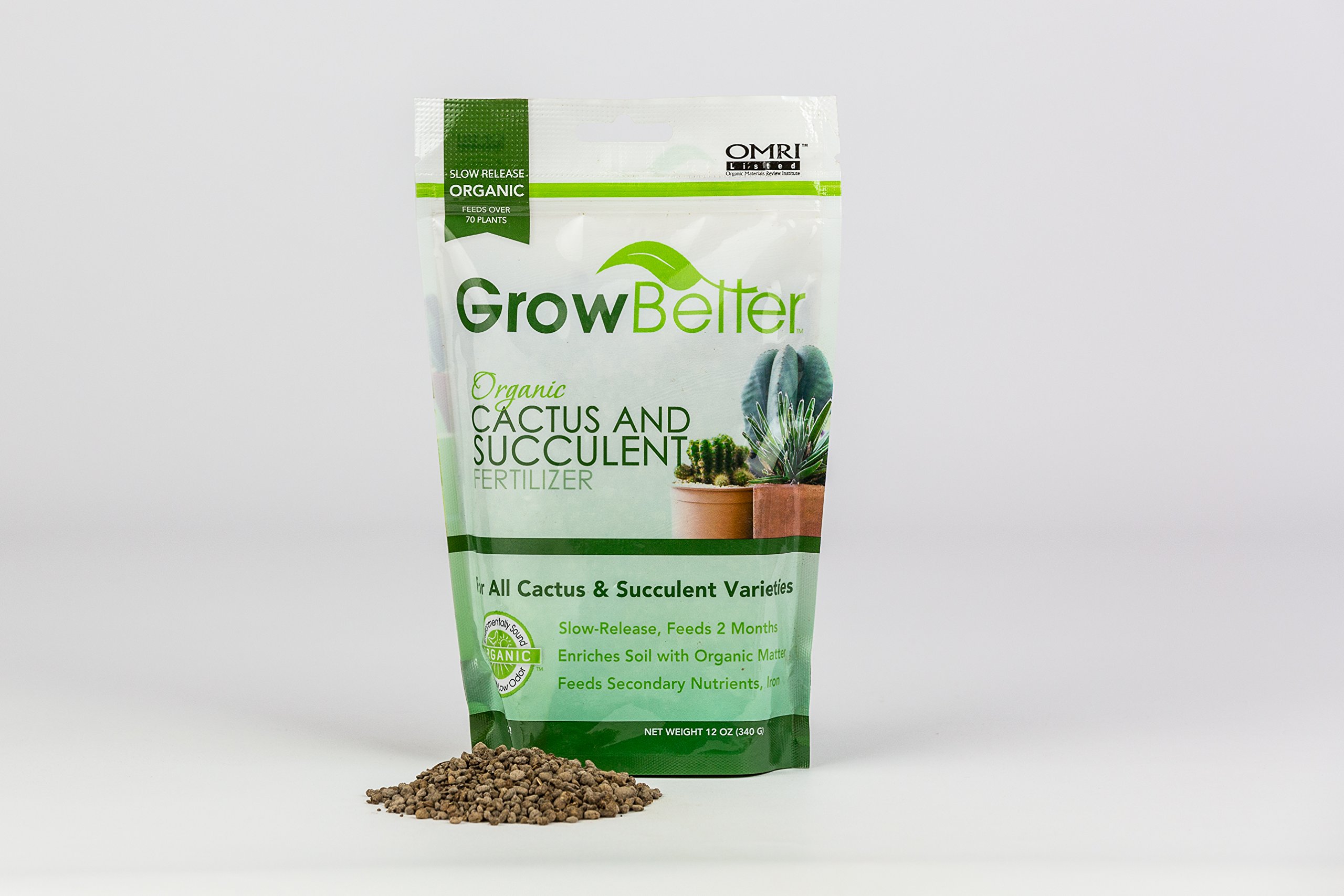Compositions of succulents
Very often, these species are grown in several pieces in one container.
But in composing the composition, it is important to choose the "right plants". That is, those that will not suppress each other
For example, you should not combine plants from different continents in one pot, since they have different living conditions. Slow growing succulents are best suited. They do not need to be repotted and adjusted frequently.
Since it is easy to care for succulents, this is an excellent option for novice florists. At the same time, you can create original compositions from them that will surprise you with their uniqueness and beauty.
Types and varieties of haworthia for growing at home

Useful information:
- a perennial plant in nature lives up to 20 years - a succulent grows very slowly;
- “babies” have been appearing next to the parental base for many years, the site is covered with a dense carpet of original plants;
- homeland of Haworthia - South Africa;
- flowering begins on the day of the summer solstice and lasts 4-5 weeks;
- what does Haworthia look like? Photos help to understand why the plant is considered one of the most original types of indoor flowers;
- most varieties are highly decorative. On the fleshy leaves there are tubercles, stripes, "windows", areas for catching light, "cilia", outgrowths from the edges, dots and specks, bizarre patterns;
- the shade of the leaf plates varies: light and dark green, gray;
- the shape of the leaves is varied: long, narrow, wide, scaphoid, obtuse at the ends.
The original succulent has many varieties. Not all varieties can be grown at home: some species require specific conditions, exactly close to natural ones.

Many varieties and types of haworthia with high decorativeness have taken root in the apartment:
- Terkovidny. The leaf plates are pointed, not wide, with multiple growths.
- Concolor. There are thin, "graceful" lines on the surface.
- Scaphoid. Bright green fleshy leaves, tubercles are practically absent, translucent elements are visible on the surface. Effective flowering - white buds on a long base.
- Retuza. Interesting shape of triangular leaves: the tops seem to be neatly shortened. In a dark room, with a prolonged lack of light, the color of the leaves changes: dark green turns into reddish.
- Drawn. Leaves growing vertically are covered with dark spots.
- Fasciata. The original look of the plant is given by multiple white stripes against the background of rich green leaf plates. Concolor and Big Ben are popular striped Haworthia varieties.
- Pearl. White tubercles along the edges of the leaves give the plant an unusual appearance. A spike at the top is another characteristic feature of the pearl variety. the shade of the petals is light green, the inflorescences are like brushes.
- Maugani. The popular view has vertical leaves, the shape is cylindrical. Transparent elements at the edge of each leaf plate help the sun penetrate into the pulp to activate the process of photosynthesis. On hot days, with a moisture deficit, the plant deepens, sinks into the soil for survival.
- Cooper. A beautiful succulent is a round rosette, fleshy leaves of a greenish-gray hue with outgrowths at the edges that resemble long eyelashes.

Sedum (sedum)
The variety of forms of these, for the most part, perennials is expressed by shrubs, herbaceous specimens or semi-shrub characteristics. The flowering period occurs in the second half of the warm season.Excellent honey plants provide the garden with a sufficient number of pollinators, so necessary for many horticultural and horticultural crops.
All Sedums are drought tolerant, preferring open spaces
When choosing green “pets” for places with cold winters, pay attention to frost-resistant varieties. Flower beds should be planted by guests before the onset of summer, after waiting for the return of possible seasonal frosts
The main concern is the need to frequently weed out weeds that can drown out both juvenile and adult species. The exception is, perhaps, one Sedum Caustic, able to cope on its own. Watering is carried out only during the onset of drought or extreme heat.
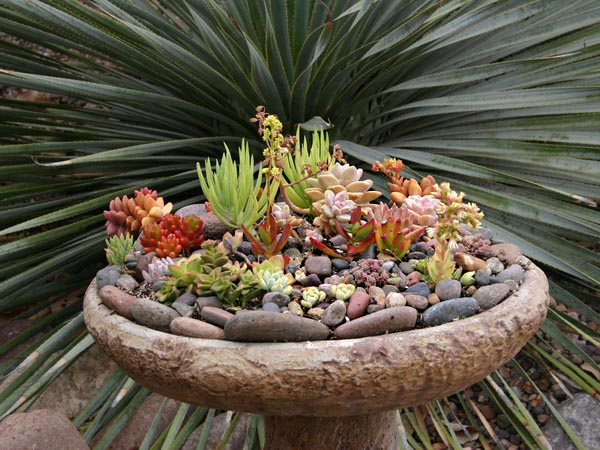
Timely shortening of growing shoots, pruning of wilted inflorescences and leaves control the decorative state. With the onset of a stable cold snap, all ground parts are cut off at a level of up to four centimeters from the soil surface. Formed "hemp" wake up with earth for wintering. Common garden species:
- The retracted Cristatum (reflexum ‘Cristatum’) is known as “Scallop”, “Cockscomb”. The varietal peculiarity is expressed by the bright green color of the leaves, which look like needles. It grows into a thick carpet;
- Prominent (S. spectabile) is bred in large varietal quantities with accents on leaf and floral coloration. Looks good in a group combination of different varieties, with conifers. There are quite tall specimens (0.8 meters in height);
- False (spurium) is represented by cleverly intertwined shoots that are able to rise (more often spread). Blooms from mid-summer. Star-like flowers are collected in corymbose inflorescences. Serve as bright color accents;
- Acid (acre) is a ground cover plant. The first year, young shoots try to take root in places of contact with the ground. In the second year, during the flowering period, the foliage drowns in rich yellow “featherbeds”;
- Spanish (S. hispanicum) forms an in-situ carpet with a striking bluish tinge. Having finished blooming, all shoots die off. Rapid rebirth occurs through self-seeding.
What ready-made mixtures are suitable, how should you choose?
For zamiokulkas you can purchase:
- soil for cacti and succulents;
- universal soil for indoor plants.
The first option is preferable: it is as similar as possible to the rocky-sandy soil “native” for an exotic plant.
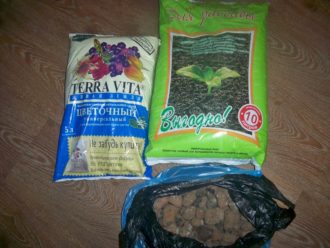 If such a soil mixture is not on sale, then you can safely purchase a universal soil, to which sand, vermiculite or expanded clay should be added during planting.
If such a soil mixture is not on sale, then you can safely purchase a universal soil, to which sand, vermiculite or expanded clay should be added during planting.
When buying ready-made soil, you need to pay attention to the following points:
- the packaging must contain information about the composition of the soil, expressed as a percentage or in quantitative terms;
- the release date and expiration date of the product must still be up to date;
- it will not be superfluous to check the integrity of the package, the absence of mold films on it;
- the soil mixture should be homogeneous, which is easy to feel when feeling the package.
Probable problems and illnesses
Pests from the outside rarely attack succulents. Sometimes nematodes can be found in the root system. Thrips can also grow in the soil. This is possible only in cases where the soil and its filler were not purchased in the store, but dug out by the owner himself. In such a situation, one should resort to reproduction by the top of the plant or make a transplant, cleaning the roots from soil particles completely, and then treat the indicated areas with disinfectants.
Succulents get sick from inexperienced flower growers. They are faced with a situation where the plant rots. This is due to non-observance of the correct irrigation regime. If there are fears that it will not be possible to protect the culture from suppuration, it is necessary to put charcoal in the soil before planting.The following problems usually arise for beginners:
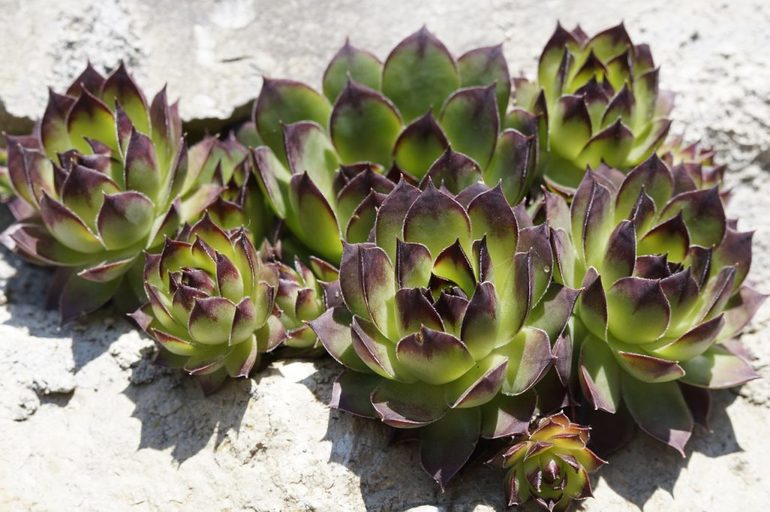
- Brown spots on the shoots and leaves. This is a sign of infection with the botrytis fungus. It provokes decay of foliage. To cure the plant, you need to cut off the leaves with a defect, reduce watering, and even better - leave the soil dry for several days. After that, the fungicide solution should be added to the substrate. This could be the "Maxim" remedy.
- Brown spots with an unpleasant odor. The causative agent of another group is to blame here. This is the erwinia bacterium. To get rid of it, you should remove the damaged areas of the plant, reduce the frequency of watering and treat the flower with a solution of potassium permanganate. For prevention, a succulent must be periodically examined. It is especially important to look at the leaves, including their lower areas.
- Plaque of green or red. It can be penigillosis or aspergillosis. The causative agent of both diseases is a fungus. To combat it, the affected leaves are treated with an alkaline solution, for example, with the addition of soda, or potassium permanganate mixed with water.
- Foliage burns. They occur if the plant is left on the southern windowsill in direct sunlight. It is especially dangerous to do this during or immediately after hibernation. Also, an unfavorable period for sunbathing is the moment after the direct purchase in the store. The plant must gradually get used to new conditions, as well as to the bright rays of the sun.
They advise doing this procedure because sometimes the substrate is infected with nematoses. They are capable of causing a lot of harm to the plant, therefore, in order to prevent, it is necessary to get rid of the soil of questionable quality. On the other hand, if there is no doubt about the qualifications of the flower shop employees and their conscientious attitude towards their work, you can do without such a procedure.
Soil care
Like any cultivated soil, the soil for cacti requires maintenance. Before planting plants, it must be calcined or steamed. To do this, you need to place some of it in a metal container in an oven preheated to 100 ° C.
Watering is a prerequisite for the normal growth and development of plants. Cacti, like many other indoor plants, require different watering intensities depending on the season. On hot summer days, you can water at least every day, but so that the soil does not accumulate moisture, but remains crumbly. With a decrease in sunlight and in winter, soil moisture must be reduced. In winter, when the plants practically do not grow (insufficient lighting), watering can be reduced to 1-2 times a month.
Fertilizer in the soil for cacti must be added regularly, for example, before the start of intensive growth in spring. Cacti need the presence of nitrogen, phosphorus, potassium and calcium salts.
For the normal development of plants, it is necessary to carry out measures aimed at combating soil organisms that pose a danger to indoor plants. The most widespread insect is the mealy rootbug. As the name implies, this creature spoils the root system, which affects the growth of the plant. The worm can crawl from one pot to another, expanding the infestation. Finding and exterminating it can be very difficult. Florists recommend for prevention periodically, for example, once a week, spray your pet with a special insecticidal composition.
Mechanical cleaning of the roots gives a good effect. To do this, you need to remove the cactus from the ground and thoroughly rinse its roots with warm water. Then the plant must be transplanted into freshly prepared soil. The contaminated soil can be calcined again in the oven, this procedure will completely destroy the pests.
How to care for the land?
Even the highest quality soil for anthuriums has its own shelf life. After a certain period of time, the substrates decompose, deplete and lose their usefulness.To extend the service life of the soil mixture, a number of simple requirements should be observed.
- Before planting an exotic plant in a fresh substrate, it is advisable to disinfect the latter. For this, the soil mixture is steamed or spilled with a solution of potassium permanganate. Thanks to heat treatment, the risk of plant diseases will decrease, the threat of their damage by pests will disappear.
- Caring for capricious anthuriums provides for periodic feeding. By regularly obtaining nutrients from the substrate, plants deplete its resources. In order for the soil mixture to remain suitable for growing plants for a long time, organic and complex mineral dressings are introduced into it. Fertilization is carried out in accordance with the recommended schedule.
- Often, due to watering with hard water saturated with salts, a dirty yellow or dirty gray coating forms on the surface of the substrate. It does not pose a particular threat to plants, but experienced flower growers still recommend to carefully clean it off. In this case, a little fresh nutritious soil is added to replace the removed surface layer.
For information on how to transplant anthurium and choose a soil, see the video below.
Succulent growing options
To answer the question of how to plant succulents, you first need to familiarize yourself with the processes of their reproduction. There are several options. You can breed plants using cuttings, leaves and seeds. If you adhere to all the recommendations from experts, then any of this method will be effective, and a new representative of the home flora will quickly appear on the windowsill. And over time, you even have to think about how to transplant succulents.
Leaf propagation is only suitable for those types of succulents in which they are thick and fleshy. For varieties with thin leaves, propagation by cuttings is used.
First of all, you need to properly prepare the planting material. This requires:
- Choose an absolutely healthy leaf or stalk.
- Take a sharp knife and wipe it with a disinfectant.
- Cut off the leaf / stalk at the very base.
Note! It is not necessary to immediately plant the taken process in the ground or put it in water. He should lie down for about 2 days and dry out a little.
If juice is released from the cutting, it must be washed off with filtered water, and then sprinkled with crushed activated carbon over the cut site. Further, the cutting can be germinated in water, only you need to make sure that it does not touch the bottom of the container. You can also germinate planting material in fine-grained sand. For this, the cutting is planted no deeper than 2 cm and is well fixed with fine gravel. The planted plant must be watered.
The germination process will be crowned with success if a stable temperature regime of about 23-25 ° C is maintained in the room. The root remedy will also benefit the plant.
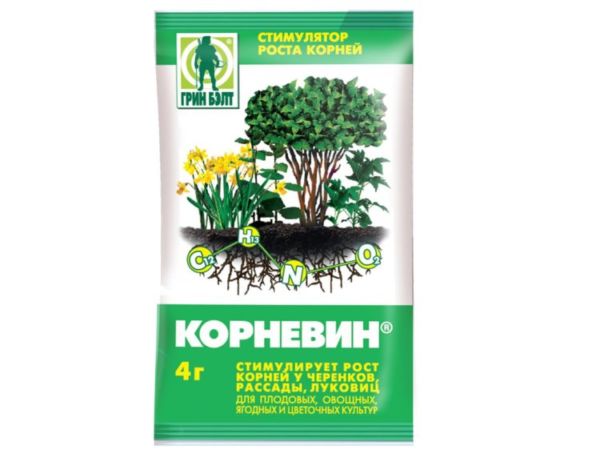
Kornevin - growth accelerator
The leaf is rooted a little differently. For him, you need to prepare a well-disinfected soil. For this, either sand or a special substrate purchased in the store is suitable, to which sand or fine-grained expanded clay is added. The leaf does not need to be planted in the ground; it is placed on dry soil at an angle so that it is convenient for it to take root.
Further, the offshoot needs proper care.
- Watering the leaf is not worth it, it is necessary to spray it periodically.
- The pot is placed in a bright place, but drafts and direct sunlight must be excluded.
- When the leaf has roots, it is planted in a special substrate for succulents.
- When the top layer of the earth dries out, the sprouted leaf needs to be watered.
Note! Cuttings start up new shoots and acquire lush foliage, and the leaf, on the contrary, dries up, so you don't need to be afraid that the plant has not taken up, everything will be fine with it
Soil selection criteria
Many novice growers buy succulents in the store, not knowing how to grow them.
After the purchase, it is important to know not only how to transplant the purchased succulent at home, but also what soil to use for this.
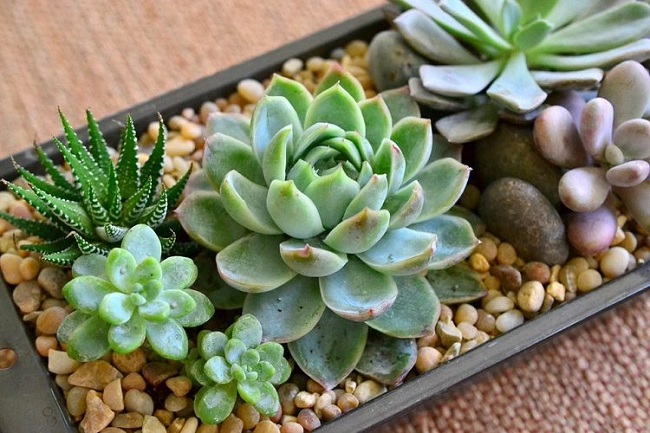
Succulents
For growing succulents, you should choose loose soil that allows air and water to pass through well. Succulents grow in both neutral and acidic soil. The soil should not contain a lot of nitrogenous fertilizers; there should be enough mineral components.
What kind of land is needed for planting succulents can be determined by the requirements determined by the preferences of the plants:
- It should be light and loose. Water must pass through it quickly.
- Soil particles must provide air to the roots.
- The top coat should dry quickly.
When buying soil in a store, you need to pay attention to its composition. Depending on the type of succulents for planting, soil requirements differ
The bulk of the purchased soil is peat. Most often, 2 types of it are mixed: riding and lowland. Peat has high acidity, so dolomite flour is added to the soil to reduce it.
Haworthia in the house: signs and superstitions
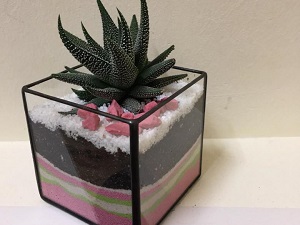
Some amateur flower growers are carefully studying information about the effect of indoor plants on the health and emotional state of households. Some people believe in omens, others consider them a relic of the past.
There is a belief that a flower grows slowly for a reason: a succulent with fleshy leaves takes bad energy from home, protects adults and children. With Haworthia in the home, the emotional microclimate becomes more pleasant. For this reason, it is useful to put a flowerpot with a Zebra cactus in places where the family often gathers.
Growing haworthia is not difficult: the flower will delight even those people who often go on business trips or do not have enough knowledge and experience in caring for capricious species: Azalea, Orchid, Indoor Rose.
An original succulent native to southern Africa, ideal for indoor cultivation. The main thing is that there is enough heat, light, there are no drafts and dampness.
More useful information about the intricacies of caring for Hawortia can be found after watching the video:
Possible growing problems
Like all plants, succulents are susceptible to disease. Rot may appear on them, which is very difficult to deal with. Some problems may be related to inadequate care. Succulents are also attacked by slugs, wood lice, mealybugs, scale insects. The spider mite is also one of the main pests. The roots often dry out due to irregular watering and improper soil fertilization.
Brown specks
Another name for anthocrosis. Common in succulents. It appears as dark or light brown spots that appear on leaves or twigs. Over time, the cactus tissue will become covered with a hard crust and dry out. If the disease has just been discovered, then the affected parts are carefully cut out, and the place of the cut is sprinkled with coal powder. It is no longer possible to return the former species to the plant, but at least it will survive.
Leaf burns
Burns occur when plants are exposed to direct sunlight. Different types of succulents react differently to this factor. Also, do not pour water on the plant itself, as this will lead to instant evaporation and burns on the plant. In order to avoid damage, the culture is transferred to partial shade. If this light is not enough, then artificial lighting is created.
Red or green patina
These signs indicate that the succulent lacks nutrients, or there is an excess of nitrogen fertilizers in the soil. Another reason for this phenomenon is the introduction of top dressing in its pure form. Plaque can appear due to pests and diseases, which are also caused by oversaturation of the soil with water. Fungal infections can easily grow in such an environment.
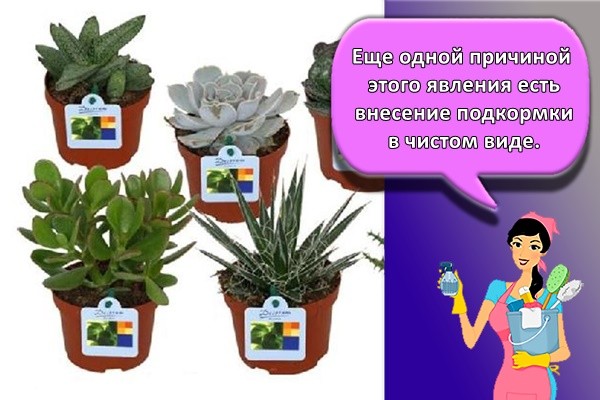
How to properly water succulents at home
Such plants store additional moisture in the leaves, since they grow in arid areas under natural conditions. Watering succulents indoors is done after the top layer becomes too dry. The process is carried out so that the liquid flows out well from the drainage holes, but does not stagnate. The drained water must be removed so that it does not damage the roots.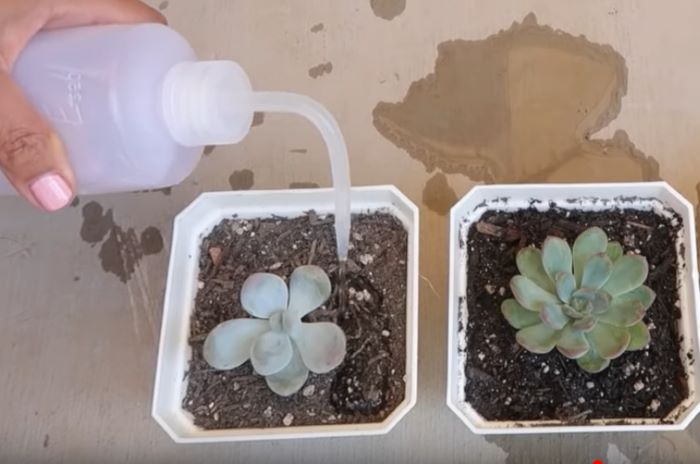
Plants need more water in spring, as crops are actively developing. In winter, the need for moisture may decrease. This is due to the fact that the amount of daylight decreases, and accordingly, succulents are in a dormant period. Their water needs are significantly reduced.
Before deciding how many times to water your succulents, pay attention to the size of the pot. The larger the container, the more moisture will be retained
Bushes that have become home to small containers need more frequent watering. In the summertime, you can take the plants outside, placing them first in shaded areas. Usually, crops that are outdoors need more moisture than those located in the room.
If you grow Sedums outdoors, be aware of weekly watering. Such crops have a stronger root system, so drought is less terrible for them. But make sure that there is no stagnation of moisture. Otherwise, it will lead to the fact that crops will disappear.
Further care
A succulent plant belongs to unpretentious plants, so even an amateur plant breeder can cope with caring for it at home. Irrigation of the soil should be regular, but not plentiful. The amount and frequency of water use are determined depending on what time of year it is. In winter, if the succulent grows at normal room temperature, watering will be enough once or twice a month. From about March, from the beginning of the growing season, irrigation is carried out once a week or 10 days.
When growing a succulent at home, it is certainly worth feeding the plant, but in small doses. Fertilizers are applied once a month or once every two weeks. It is recommended to choose complex compositions containing potassium and phosphorus, but practically free of nitrogen. The solution must be weak. Top dressing is carried out according to the instructions.
While young sprouts have not yet matured, caring for them should be slightly different from usual. The optimum temperature in this situation ranges from 22 to 30 degrees Celsius. The difference between winter and summer temperatures should be smooth.


Care
The money tree is not considered a demanding and capricious plant. It is easy to care for, so it is often chosen for growing by novice growers. But this plant also needs to create certain conditions:
- The fat woman loves a lot of light, but it is better to protect her from direct sunlight.
- For a proportional and uniform crown, the plant is periodically turned in the light.
- During the growing season, the room temperature should be between +20 and +25 degrees Celsius. During the rest period, it is desirable to reduce it to +14 degrees.
- If there are no conditions to ensure winter dormancy, the container with the tree is moved away from heat sources and the frequency of watering is reduced.
- The plant should be watered sparingly, since with an excess of moisture, its roots rot. Lack of water leads to leaf lethargy, yellowing and dropping. Therefore, the plant must be watered as the clod of earth in the pot dries out.
- Fertilizer for succulents is used for feeding. In the summer, it is brought in 2 times a month. No feeding is required in winter.
- The plant loves fresh air, and does not tolerate drafts and temperature changes.
- When the crown is larger than the diameter of the pot, you need to prepare the tree for transplanting.
- The pot should contain drainage and holes.
- Within 1 week after transplanting, it is better not to water the fat woman, but only to spray it abundantly.
- A money tree purchased from a store can be replanted 7-14 days after purchase. This time is required for the plant to get used to new conditions.
We talked about the fact that the choice of a suitable soil for the money tree is a mandatory procedure. Only if this condition is met, the plant will develop correctly, delighting its owners with rich green leaves.
How to tell if a succulent needs to change its substrate?
 The first time you need to change the soil for a dollar tree is necessary immediately after purchasing it in a flower shop.
The first time you need to change the soil for a dollar tree is necessary immediately after purchasing it in a flower shop.
Since the plant is transported from afar, suppliers are planted in a special substrate to preserve its root system. This soil is ideal for transportation, but in no way intended for the growth and development of zamiokulkas.
Further transplants of zamiokulkas must be started when, after watering, the water stagnates in the pot on top of the soil. Ideally, a loose substrate, completely entwined with plant roots, will quickly let moisture through, and it will safely fall into the pan.
A caked earth lump is a serious obstacle in the path of water: the liquid is not able to saturate the soil and remains on the surface, which threatens the plant with the formation of rotting areas, and in the future - death. Another signal that the plant needs a transplant is the roots sticking out of the drainage hole.
You should not neglect unscheduled transplants, the need for which may be indicated by the following factors:
- covering the surface of the soil with mold;
- decay of roots;
- suspension of plant growth;
- flower disease;
- damage to the flowerpot.
The growth and development of zamiokulkas depends on many factors, the choice of the right soil is not the last of them
Having paid due attention to this issue, as well as following all the rules for caring for the plant, it will be possible to get real pleasure from contemplating the lush and rich greenery of the dollar tree for a long time.
Follow-up care rules
After planting, like any other plant, succulents need care. They may be persistent, but still picky about leaving. Watering and feeding should be regular. The key to success is consistency.
Lighting
The plant needs abundant light, since its native place is desert. Succulents are not placed on the northern part of the house, as there is poor consecration. If there is no other way out, then additional consecration will be required. Some species are protected from direct sunlight. For example, aloe can get burned. Therefore, during the day, such plants are removed from the windowsill.
Temperature regime
Maintain a high temperature all year round. The most comfortable temperature is 25 degrees. The air humidity should be low. It is required to take care of the plant in such a way as to create a natural habitat for it. A humid climate will harm aloe or cactus.
Watering mode
It takes into account the time of the year, air humidity. During the period of active growth, watering is carried out once every 1-2 weeks. In winter, at low temperatures, this period is extended (every 2-3 months). Do not dry out the roots. The soil is allowed to remain dry for 3 days after irrigation. Watering is an important part of succulent care.
Top dressing
Plants also need feeding. You can buy ready-made mixtures at the store. In winter, fertilizers are not applied, since the plant is at rest. Top dressing is carried out with the arrival of spring, once a month. In fertilizers, a high nitrogen content is not allowed, because this will lead to root rot.
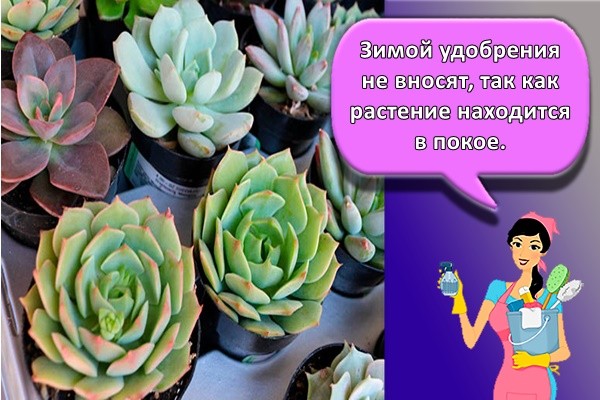
Step by step actions
Having prepared everything you need, you can start the transplant.
- First, you need to remove the flower from the old pot. To do this, you can easily knock on the bottom and walls. If that doesn't work, try making gaps around the perimeter of the pot.
- When the succulent is removed, it is imperative to inspect the condition of the roots. And for this you need to destroy the earthen lump - completely (for a young plant) or partially (if the plant is already an adult).It is better to remove soil in a dry state. If damage is found, they need to be cut off, and the remaining roots should be rinsed with potassium permanganate. Be sure to dry wet roots and only then proceed with further actions.
- We put stones and a couple of centimeters of earth in a pot at the bottom. We try on the plant so that the line where the root growth ends is one centimeter below the edge of the pot.
- Then we begin to slowly add earth, trying to pour it evenly from all sides. Shake the pot slightly to distribute the contents evenly. If there is only one plant, place it in the center. If there are several of them, it is better to separate the roots with plastic partitions. Before planning a group boarding, be sure to check their compatibility information.
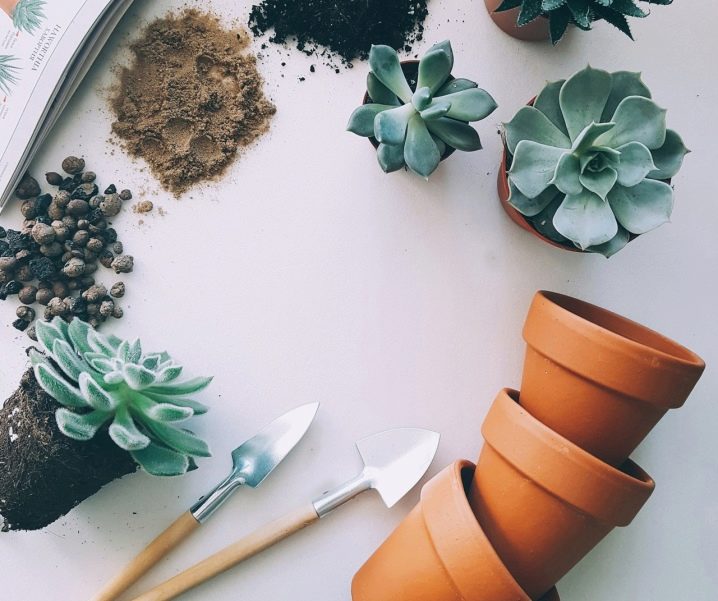
Cactus care
Cacti are evergreen plants of the cactus family. They are characterized by a thick stem with spines and hairs instead of leaves, single flowers, juicy but not edible fruits. For cacti, proper care is very important, with an abundance of light, moisture, with an optimal temperature, as well as timely fertilization.
After purchase, the plant is transplanted. If rot, damage is found on its root system, they are immediately removed. For full growth, future flowering, wide, shallow pots are suitable. The soil should be nutritious, with a slight acidity (optimal pH = 4 - 6). A mixture of humus, sand and peat is fine. It is not worth alkalizing the soil too much - cacti will grow poorly and constantly hurt.
Lighting is required for cacti diffused, and therefore they should not be placed in direct sunlight. Watering is needed regularly in summer and rarely in winter when the plant is dormant. Cacti love fresh air, but do not tolerate drafts. They feel great at a temperature of + 17 ... + 25 °, but during the period of winter rest it is reduced to + 9 ... + 15 °. Cool wintering is needed for cacti to lay future flower stalks. If they grow at the same temperature all year round, then you can forget about flowering.
Top dressing of cacti is carried out from the beginning of spring to the end of September. For this, complex mineral compositions, liquid purchased organic matter or special products marked "for cacti" are used. During the period of growth and development, fertilizer is applied twice a month, during the rest period, feeding is stopped.




